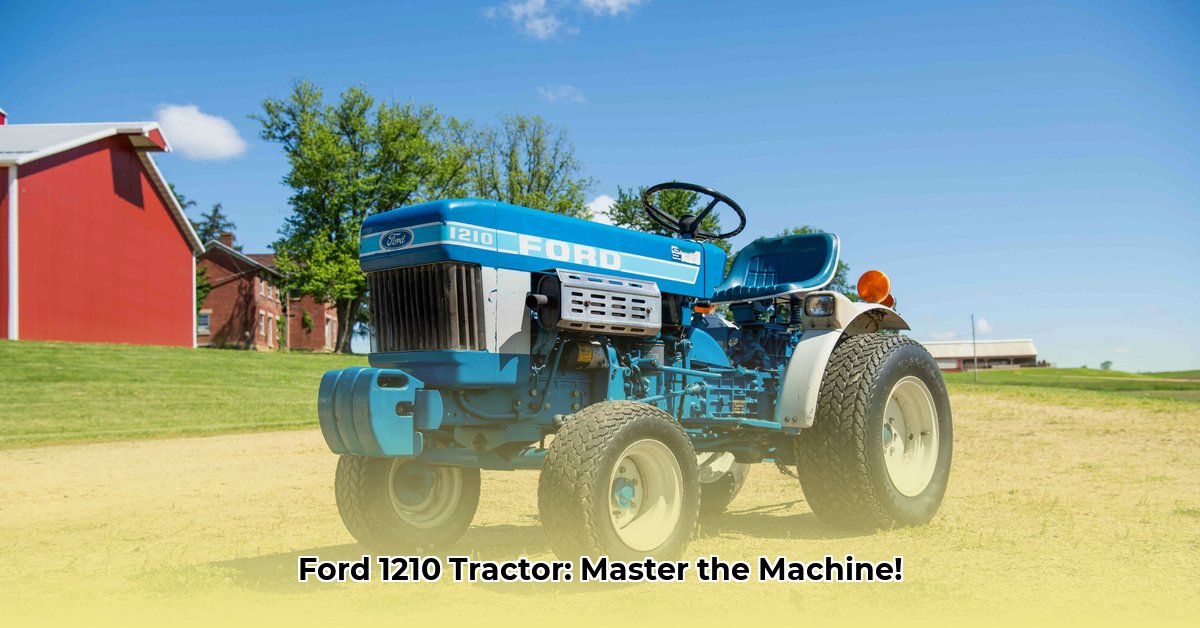
This comprehensive guide explores the Ford 1210 tractor, a robust machine with a rich history. We cover its origins, mechanical specifications, maintenance, repair, and even restoration, providing insights for farmers, hobbyists, and vintage tractor enthusiasts alike. Whether you're considering purchasing, already own one, or are simply curious, this guide offers valuable information. For more Ford tractor info, check out this great resource.
A Look Back: The Ford 1210's Legacy
The Ford 1210, produced from 1983 to 1986, represents a significant collaboration between Ford and Shibaura Machinery of Japan. This partnership reflects a pivotal shift in the agricultural equipment market towards smaller, fuel-efficient tractors. Rising fuel costs in the 1980s drove demand for machines that balanced power with economy, and the 1210 admirably filled this need. Its compact design and versatility quickly established it as a reliable workhorse for a variety of agricultural tasks. What made this tractor stand out against competitors from that era?
Under the Hood: Mechanical Specifications
The Ford 1210 boasts a three-cylinder, 0.9-liter Shibaura diesel engine, delivering approximately 16 horsepower (net) and around 13.5 horsepower to the power take-off (PTO) – the shaft that powers implements like mowers and tillers. This compact powerplant is paired with a 10-speed geared transmission (some models offered a hydrostatic option), providing a wide range of operational speeds. The hydraulic system, while relatively simple, provides sufficient lift capacity for common attachments. Is this power sufficient for modern agricultural demands? Let’s look at the specifications.
| Specification | Details |
|---|---|
| Engine | Shibaura 3-cylinder diesel, 0.9 liters |
| Horsepower (Net) | Approximately 16 hp |
| PTO Horsepower | Approximately 13.5 hp |
| Transmission | 10-speed geared (Hydrostatic optional) |
| Hydraulic System | Open-center |
| Fuel Capacity | (Consult Owner's Manual) |
Operational Capabilities & Attachments
The Ford 1210's true strength lies in its adaptability. A three-point hitch system allows for easy attachment of tools like mowers, loaders, tillers, and more. This versatility makes it suitable for a range of tasks, from mowing lawns to cultivating fields. How many different attachments were commonly available for the Ford 1210?
Maintaining Peak Performance: Maintenance & Repair
Regular maintenance is paramount to extend the life and reliability of your Ford 1210. Neglecting these tasks risks more significant (and costly) repairs later. What percentage of Ford 1210 failures are due to preventable maintenance issues?
Fluid Changes: Adhere to the schedule in your owner's manual for engine oil, transmission fluid, and hydraulic fluid changes. Clean fluids are vital for avoiding component damage.
Filter Replacements: Regularly replace air, fuel, and hydraulic filters. Clogged filters drastically reduce performance and can cause engine damage.
Belt Checks: Inspect belts for wear and tear. Replace any damaged belts promptly to avoid unexpected breakdowns.
Electrical System: Check for corrosion and loose connections. Addressing minor electrical issues prevents larger problems.
Locating replacement parts may require some effort. While some parts are still readily available through online retailers and specialized suppliers focusing on vintage tractors, others may require more searching.
Buying a Used Ford 1210: A Buyer's Guide
Purchasing a used Ford 1210 requires careful inspection. Don’t rush into a purchase!
- Engine: Listen for unusual noises or knocking sounds. Check for oil leaks.
- Transmission: Ensure smooth shifting through all gears.
- Hydraulic System: Test the lift capacity and look for leaks.
- Chassis: Check for rust, corrosion, or structural damage.
- PTO: Thoroughly test the PTO functionality.
Research fair market values before making an offer. Remember, condition greatly impacts value. A pre-purchase inspection by a qualified mechanic is highly recommended.
(Optional) Restoration: A Labor of Love
Restoring a Ford 1210 is a rewarding but challenging project. Sourcing parts can be time-consuming. Online communities dedicated to vintage Ford tractors are excellent resources for both parts and advice from experienced restorers.
Conclusion: A Lasting Legacy
The Ford 1210, a product of its era, offers a compelling blend of simplicity, reliability, and versatility. While parts availability and some design limitations exist, proper maintenance and care can ensure years of dependable service. Its legacy underscores the enduring quality of well-engineered machinery. Is this tractor a worthwhile investment for modern agricultural needs?